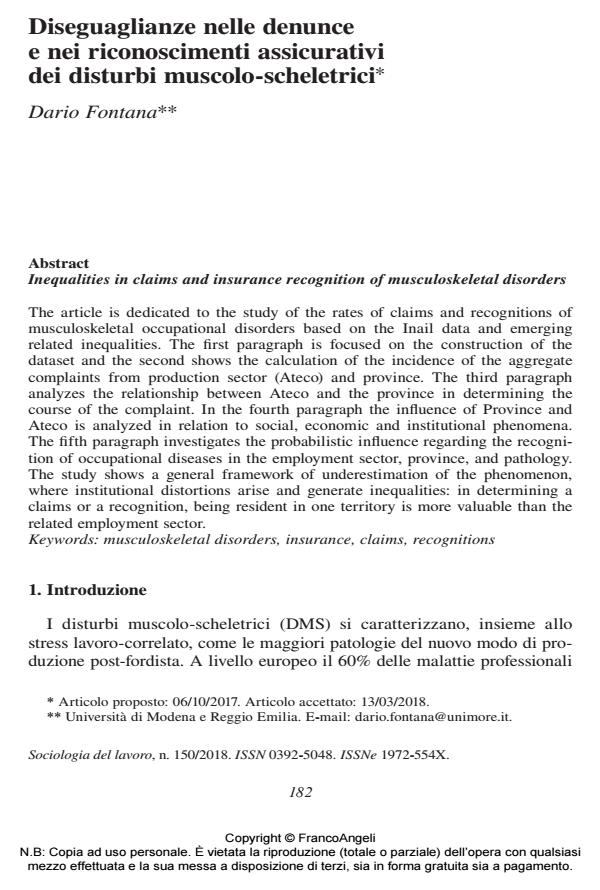Inequalities in claims and insurance recognition of musculoskeletal disorders
Journal title SOCIOLOGIA DEL LAVORO
Author/s Dario Fontana
Publishing Year 2018 Issue 2018/150 Language Italian
Pages 20 P. 182-201 File size 220 KB
DOI 10.3280/SL2018-150010
DOI is like a bar code for intellectual property: to have more infomation
click here
Below, you can see the article first page
If you want to buy this article in PDF format, you can do it, following the instructions to buy download credits

FrancoAngeli is member of Publishers International Linking Association, Inc (PILA), a not-for-profit association which run the CrossRef service enabling links to and from online scholarly content.
The article is dedicated to the study of the rates of claims and recognitions of musculoskeletal occupational disorders based on the Inail data and emerging related inequalities. The first paragraph is focused on the construction of the dataset and the second shows the calculation of the incidence of the aggregate complaints from production sector (Ateco) and province. The third paragraph analyzes the relationship between Ateco and the province in determining the course of the complaint. In the fourth paragraph the influence of Province and Ateco is analyzed in relation to social, economic and institutional phenomena. The fifth paragraph investigates the probabilistic influence regarding the recognition of occupational diseases in the employment sector, province, and pathology. The study shows a general framework of underestimation of the phenomenon, where institutional distortions arise and generate inequalities: in determining a claims or a recognition, being resident in one territory is more valuable than the related employment sector.
Keywords: Musculoskeletal disorders, insurance, claims, recognitions
- Askenazy P. (2005). Sur les sources de l’intensification. Revue economique, 56(2).
- Askenazy P., Caroli E., Gautié J. (2011). Un panorama des bas salaires et de la qualite de l’emploi peu qualifie en France. Université Paris1 Panthéon-Sorbonne (Working Papers).
- Barros A.J., Hirakata V.N. (2003). Alternatives for logistic regression in crosssectional studies: an empirical comparison of models that directly estimate the prevalence ratio. BMC medical research methodology, 3(1).
- Biddle J. (2001). Do High Claim-Denial Rates Discourage Claiming? Evidence from Workers Compensation Insurance. The Journal of Risk and Insurance, n. 4.
- Carnevale F., Baldasseroni A. (1999). Mal da lavoro: storia della salute dei lavoratori. Roma: Laterza.
- Costa G. et al., a cura di (2014). Equita nella salute in Italia. Secondo rapporto sulle diseguaglianze sociali in Sanita. Milano: FrancoAngeli.
- Davies R., Jones P., Nunez I. (2009). The impact of the business cycle on occupational injuries in the UK. Social Science & Medicine, 69.
- Di Nunzio D. (2009). Le difficili condizioni di salute e di sicurezza dei lavoratori atipici in Italia: Frammentazione, Atomizzazione e Scarse Tutele. Revista Brasileira de Estudos Politicos, 99(2).
- Di Stefano L., Fontana D. (2017). Disturbi muscolo-scheletrici e lavoro: una mappatura critica. Quaderni Fondazione Marco Biagi – sezione ricerche, 1.
- Eurofound (2009). Working conditions in the European Union: Working time and work intensity. Dublin: Eurofound.
- Eurogip (2015). Reporting of occupational diseases: Issues and good practices in five European countries. Paris: Eurogip.
- Eurogip (2016). Musculoskeletal disorders: What recognition as occupational diseases? Paris: Eurogip.
- Fontana D., Tuccino F. (2015). Effetti sulla salute nella Lean Production: il settore auto in Europa. Studi Organizzativi, 1. DOI: 10.3280/SO2015-001002
- GLNFI (2015). Utilizzo dei sistemi informativi correnti per la programmazione delle attivita di prevenzione nei luoghi di lavoro. Le malattie professionali. Firenze.
- Hatzfeld N. (2009). Les malades du travail face au déni administratif: la longue bataille des affections périarticulaires (1919-1972). Revue d’histoire modern et contemporaine, 56(1).
- Heck R., Tabata L., Thomas S. (2014). Multilevel and longitudinal modeling with IBM SPSS. New York: Routledge.
- Inail (2016). Rapporto statistico 2016. Roma: Inail.
- Latza U., Kohlmann T., Deck R., Raspe H. (2000). Influence of occupational factors on the relation between socioeconomic status and self-reported back pain in a population-based sample of German adults with back pain. Spine, 25(11).
- Masino G. (2005), Le imprese oltre il fordismo. Roma: Carocci.
- Morse T., Punnett L., Warren N., Dillon C. (2003). The Relationship of Unions to Prevalence and Claim Filing for Work-Related Upper-Extremity Musculoskeletal Disorders. American Journal of Industrial Medicine, 44.
- Punnett L. (2014). Musculoskeletal disorders and occupational exposures: How should we judge the evidence concerning the causal association? Scand J Public Health, 42.
- Roquelaure Y. (2015). Musculoskeletal disorders: a major challenge for occupational risk prevention in Europe. ETUI Policy Brief, 9.
- Rosenman K.D. et al. (2000). Why most workers with occupational repetitive trauma do not file for workers’ compensation. Journal of Occupational and Environmental Medicine, 42(1).
- Rothman K., Greenland S., Lash T. (2008). Modern epidemiology. Philadelphia: Wolters Kluwer Health.
- Westgaard R.H, Winkel J. (2011). Occupational musculoskeletal and mental health: Significance of rationalization and opportunities to create sustainable production systems – a systematic review. Applied Ergonomics, 42.
- Predictive validity of an indicator of exposure to unfavorable ergonomic working conditions on work-related musculoskeletal disorders Dario Fontana, Chiara Ardito, Giuseppe Costa, Barbara Boschetto, Angelo d’Errico, in Quality & Quantity /2023 pp.4545
DOI: 10.1007/s11135-022-01552-0 - Job quality in worker cooperatives: Beyond degeneration and intrinsic rewards Lisa Dorigatti, Francesco E. Iannuzzi, Valeria Piro, Devi Sacchetto, in British Journal of Industrial Relations bjir.12798/2024
DOI: 10.1111/bjir.12798
Dario Fontana, Diseguaglianze nelle denunce e nei riconoscimenti assicurativi dei disturbi muscolo-scheletrici in "SOCIOLOGIA DEL LAVORO " 150/2018, pp 182-201, DOI: 10.3280/SL2018-150010